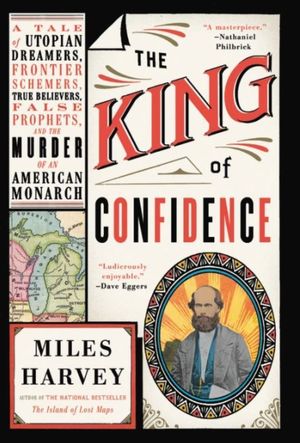In this year of remote work and canceled vacation plans, the most engrossing virtual trip I’ve embarked on transported me to a Mormon kingdom on a Lake Michigan island during our nation’s antebellum era.
And it’s an outstandingly entertaining excursion.

The King of Confidence, by Miles Harvey, recounts the true but little-known story of James Strang, a young attorney from upstate New York who appeared in frontier Wisconsin in 1843 and later declared himself the spiritual successor to Joseph Smith, the founder of Mormonism and the Latter-day Saint movement. Smith was murdered by an angry mob in Nauvoo, Illinois, in 1844.
While most of the early Latter-day Saints went west with Brigham Young to establish their new settlement near Great Salt Lake in Utah, a breakaway group was drawn to Strang. He convinced hundreds of converts to move with him to Beaver Island in Lake Michigan, where he had himself crowned “King of Earth and Heaven.” (The royal throne was constructed of boards, upholstered with painted cloth and stuffed with tree moss, and Strang’s crown was made of paper.)
Woven into his life story are the Erie Canal, polygamous Mormons, Great Lakes pirates, abolitionists, President Millard Fillmore, horse thieves and an efficient, young private secretary who wasn’t quite what he appeared to be.
Although a tale of a different time, Strang’s adventures have parallels today. He adeptly used the media to craft an image of himself and his movement. His exploits were covered extensively in local newspapers — and those stories were reprinted and embellished in other newspapers across the country.
“Like P.T. Barnum, Strang had discovered that there was no such thing as bad publicity, that once a story was reprinted enough times, it took on a life of its own — one which an astute manipulator of media could constantly find new ways to exploit,” writes Harvey, a professor of English at DePaul University in Chicago.
That rings true today, in the era of misleading or fictional claims that are regularly believed and amplified on cable news and social media. QAnon, anyone?
The United States was fertile ground for utopian communities in the 19th century. Seeking a sense of belonging, people were drawn to such settlements, often contributing their labor and all their worldly possessions in the hope of success.
The nation’s history is replete with examples of shady characters reinventing themselves. That was true of the King of Earth and Heaven. In 1851, the federal government sent a U.S. Navy warship to the island to arrest Strang on charges including illegal logging and obstructing the mail. Two years later, he was an elected and respected member of the Michigan House of Representatives.
Harvey adroitly places King James in the context of his times, even tracking down an 1849 use of the phrase “confidence man” in The New York Herald to describe what had become a ubiquitous part of American culture.
Such characters drew a steady stream of appellations, including charlatan, trickster, humbug and flim-flam man. Anyone who’s read the entertaining exploits of the Duke and the King in The Adventures of Huckleberry Finn will recognize the type.
“Seer, swindler, idealist, impostor, saint, thief, genius, clown — at one time or another all described James Jesse Strang, a true American original,” Harvey writes.
There’s nothing new under the sun. We fool ourselves by assuming we’re too modern or educated to be drawn into such schemes. Every age will have its James Strang-like figures who will attract devoted followers in search of a sense of belonging.
Margaret Fosmoe is an associate editor of this magazine.